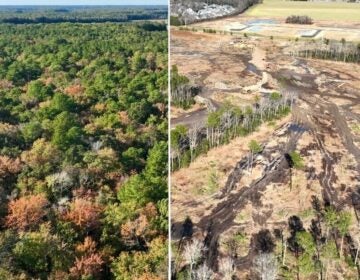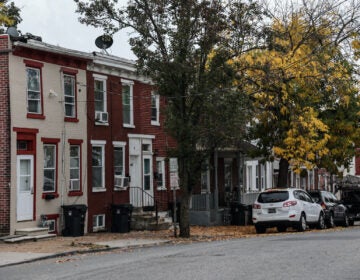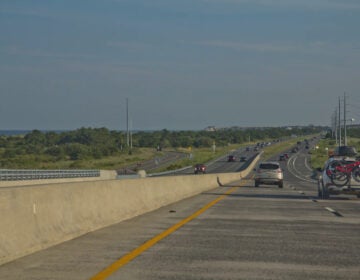No more ‘knocking trees down to the property line’ for Sussex County developers
Environmentalists have bemoaned the loss of 43,000 acres to development and say more is needed, but county leaders laud the compromise law.
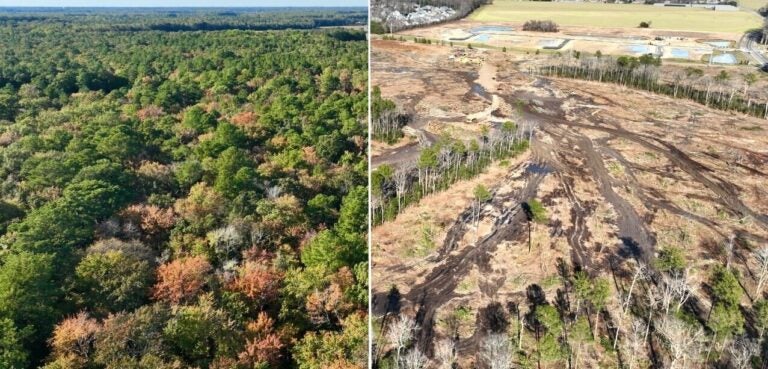
This before and after photo shows the clear-cutting of a once-forested area near Rehoboth Beach. (Courtesy of Sussex Preservation Coalition)
From Philly and the Pa. suburbs to South Jersey and Delaware, what would you like WHYY News to cover? Let us know!
Delaware’s southernmost county, reeling from the destruction of at least 43,000 acres of woodlands for development since 1998, has expanded its laws to protect trees where housing subdivisions are being built.
Sussex County Council approved a new “perimeter buffer’’ ordinance last week after years of calls by environmentalists to better preserve forests in the largely rural county, where the population has nearly doubled to 250,000 over the last quarter century.
Under the current code, which remains in effect through February, the county must give “consideration’’ to the “minimization’ of tree loss in deciding whether to approve development applications. The code also requires a 20-foot perimeter buffer of trees between new subdivisions and adjoining properties.
The new law, which came after a series of public hearings:
- Requires developers to maintain a 30-foot wooded buffer along the neighborhood’s perimeter that consists either of existing trees or new plantings, to create a “visual landscaped screening”
- Mandates the creation and maintenance of an additional 20-foot “buffer protection area” between the woods and building lots. This open space area aims to ensure that woodlands “are not disturbed,” especially during construction
- Pevents clear-cutting in the buffer area but allows existing trees to be cut down if they are less than six inches wide at chest height. Two trees must be planted, however, for every one removed, and each must be at least six feet tall
- Establishes fines of $10,000 per quarter acre for clear-cutting trees in a designated buffer
- Requires developers to submit their plans for the buffer area before beginning construction, including a “certified” forest assessment of existing woodlands within 30 feet of the perimeter
However, the new code does not prohibit clear-cutting of other woodlands outside the required buffer.
Todd Lawson, the county government’s chief administrator, said he’s pleased that council members took action.
“Developers were knocking trees down all the way to the property line and then coming back behind that and replanting smaller sapling trees,’’ Lawson said. “They don’t grow very fast, and it takes quite a while to have that perimeter buffer grown back up.”
Lawson said the changes were “a long time coming … a direct reaction to comments and feedback that they were hearing from the constituents of Sussex County.”
Lawson stressed that the county wants responsible growth.
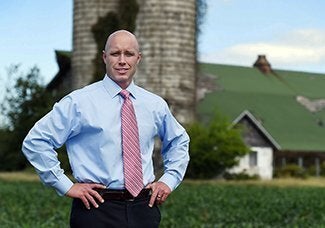
“You’ll see better buffers and better separation between the adjoining properties where you look out your backyard and you see trees that are mature, that have been protected,’’ Lawson said. “And that creates some kind of natural screening, maybe some small habitats for wildlife, certainly some water quality improvements by keeping the trees in their natural state.”
County Council President Michael H. Vincent said history will judge the elected body by “what we leave for future generations” and praised the spirit of cooperation among competing interests.
“This ordinance addresses some long-held building practices that might have worked in another time, but are less desirable in today’s environment,” Vincent said. “I think it’s a compromise that hopefully will make everyone happy, and certainly one that makes for a better Sussex County, today, tomorrow, and beyond.”
‘Insufficient to meet needs of the environment’
While county leaders are lauding the new law, not everybody shares their sanguine view.
Jane Gruenebaum, who until recently headed the Sussex Preservation Coalition and is now running for County Council, has been pushing for better woodland protections in recent years. Her group, for example, had tried in vain to prevent the clear-cutting of more than 100 acres of trees for a subdivision near Rehoboth Beach.
Gruenebaum said the new law is a “very positive step forward” but noted that Sussex County’s protections still lag behind those in surrounding counties. For example, developments in the designated “growth zone” built on more than 50 acres in neighboring Kent County must include preserving at least 50% of woodlands.
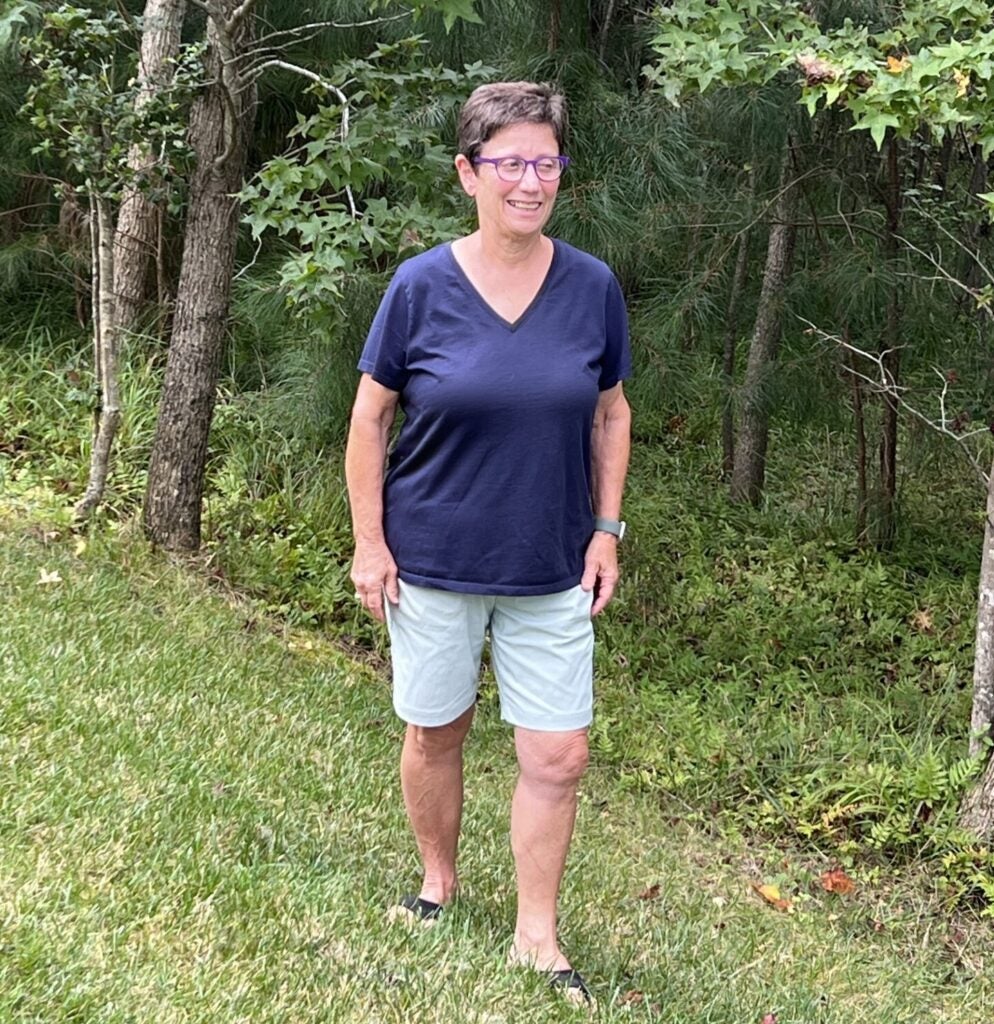
Beyond bigger buffers and requirements against clear-cutting in that 30-foot-wide section, she’s pleased that there are more plantings, inspections and enforcement now in the code.
“So this is new for Sussex County,” she said. “In the past, we’ve had ordinances that said one thing, and developers did another. There were no repercussions.”
She’s also pleased that “if there are no woodlands [in the buffer zone], they have to plant trees between developments.”
Yet having 50 feet of buffer isn’t enough, said Gruenebaum, who promised to continue her fight for greater protections if elected in November. The Democrat faces incumbent Republican Mark Schaeffer.
“It’s insufficient to meet the needs of the environment both in terms of protecting and ensuring biodiversity,’’ she said, “but also in terms of the many benefits that forests provide, from cleaning the air to holding back erosion to mitigating flooding.”
Gruenebaum, who moved to Sussex County from Washington, D.C., several years ago, emphasized that she’s not anti-growth.
“We don’t want to stop development. That’s not the issue,’’ she said. “But to try and help developers build in such a way that we protect this very critical environmental system that we’re that we had and we’re losing.”
Kyle Hoyd, the state forester in the Department of Agriculture, echoed Gruenebaum’s sentiment that the new law amounts to needed but only incremental change.

“I do think it’s a good step. Do I think it is a silver bullet? No,’’ Hoyd said.
“A lot has to happen still, but for the county, bringing this forward, listening to the constituents, listening to all the different groups that sit out there, I think that’s an important step forward on having trees as the topic of discussion,” he said.

Get daily updates from WHYY News!
WHYY is your source for fact-based, in-depth journalism and information. As a nonprofit organization, we rely on financial support from readers like you. Please give today.



